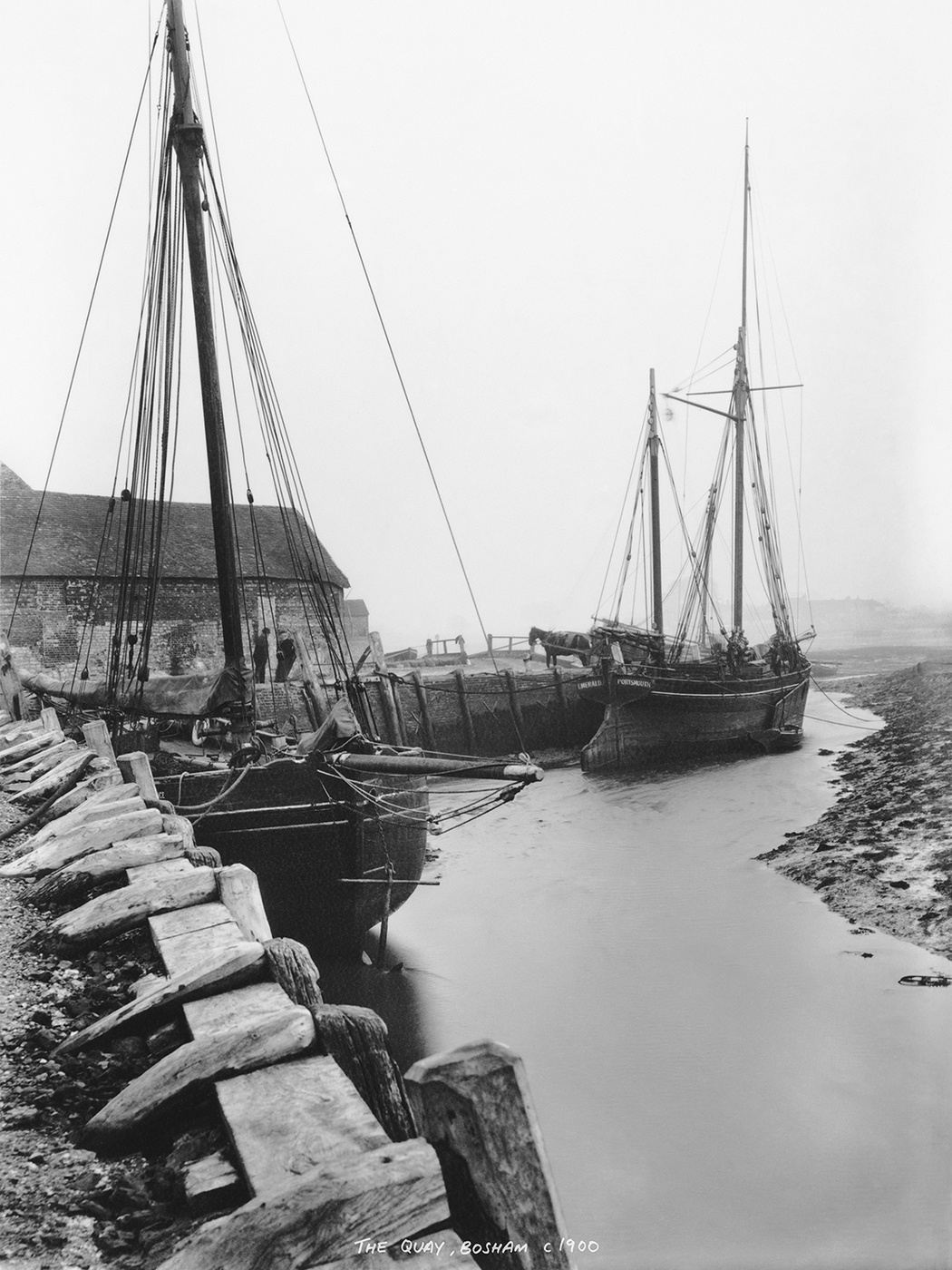
Prior to 1900, when this photograph was made, Bosham had been a thriving commercial port for freight transport along Britain's coastline for over 300 years.
This scene shows two trading ketches, one of them The Emerald, tied to Bosham Quay being unloaded by horse and cart at low tide. On the left, two mariners can be seen leaning against the oak piles of the Quay chatting.
Before the railways arrived on the south coast in 1846, Britain was very much a seafaring nation. Many ports, both large and small, could be found all along her coastline with resident mariners and fishermen. The fame of the good quality, high-yielding grain of the Bosham farmland, due to the above average sun hours and good fertile soil, has been known since Roman times. Bosham's outgoing sea trade from the seventeenth to the nineteenth century was based predominantly on wheat and maize, ground in one of the many local mills, most of it transported around the English coast by 30-ton ships. In the eighteenth and nineteenth centuries, Chichester Harbour was primarily used to transport domestic freight along Britain's coast (a small amount of freight was sent abroad to Ireland, the Netherlands and Belgium, about 10%).
By 1800, Bosham was a busy port handling a great variety of incoming goods. Bosham's trading ketches were the lorries and trucks of their day. They carried tons of essential cargo along the south coast, and all up the east coast. Usually the ketches were small, family run businesses and they were complete workhorses. The constant repair and maintenance needed to keep them afloat meant an ecosystem of chandlers, boatbuilders, merchants and sailmakers thrived around Bosham Quay. The old barn on the Quay (known as the Raptackle) was used to house rope, tools and gear for a busy shipping trade, as well as to sort and pack oysters. When trading ketches unloaded alongside Bosham Quay, the mariners attached ropes to the top of their masts to a ring on the far side of the Quay. This was done regularly with larger vessels, in order that they should stay upright and lean against the oak piles of the Quay when the tide went out, and not topple over outwards.
The biggest and oldest boatbuilding yard in Bosham was one owned successfully by several generations of the Apps family, and was situated next to Quay Meadow near the church. Towards the end of the nineteenth century this yard built some of the largest schooners for trading around the coasts of Britain and the Continent. Another yard run by Thomas Smart along the Trippet also built large trading schooners, as well as specialising in building fishing boats.
At Bosham, their holds were filled with grain for West Country ports and for those in Kent. Some travelled up the east coast of England, some as far as Newcastle. Boats sailing to the West Country returned with granite and slate, and those to Kent ports and Newcastle returned with coal. A great number of other goods were transported by coastal shipping and the 1851 Table of Tolls payable to the Lord of The Manor of Bosham lists 48 items - including oil, tar, iron, timber, sand, leather hides, wine, hops, cloth, bacon, butter, and so on.
Bosham's mariners who loaded & unloaded the trading vessels and crewed on them also worked as fishermen. Bosham had primarily been a fishing village throughout its two-thousand-year history, and fishing was a useful fall-back when boats were held up in port for reasons such as a lack of sufficient cargo, or the carrying out of necessary repairs to the ketches.
In 1846 the London, Brighton and South Coast railways arrived in Bosham, and it led to a decline in coastal shipping. The carrying of freight on the railway lines was in direct competition with the freight carrying coastal vessels. It was inevitable that the railways should gain business at the expense of the sea traders simply because of the superior speed of the railways. For example, in the 1870s the journey from Bosham to Exeter by sea took between 24 and 30 hours, depending on wind and tide; but by rail, it took only about 8 hours. When perishable goods were being carried, as was often the case, these relative times were of great importance. However, the railways did not have an immediate, dramatic effect upon the coastal trade. In fact, several of Bosham's oldest shipbuilding yards felt sufficiently confident about the continuation of the coastal trade that they continued building large trading schooners throughout the whole of the nineteenth century, and into the first decade of the twentieth century.
By 1880 most of the coastal sea trade coming into Chichester Harbour was in the form of coal, and in 1882 Thomas Smart built and launched the Lady of the Lake (84 tons) specifically to carry coal from Newcastle, along with the two-masted schooner The Two Sisters (124 tons). Building ships of this size was a significant investment, for example when Thomas Apps launched the large trading schooner The Good Hope (115 tons) from his yard in 1903, it had been on the stocks being built for over 20 years. She was used for trading along the coast until 1916, when she was sunk by enemy action during World War I.
Nevertheless, the coastal trade did slowly decline in the second half of the nineteenth century after the arrival of the South Coast Railways, and by the early twentieth century rail freight had practically taken over from sea freight.
This photograph then, made in 1900, captures the end of an era and gives us a glimpse of the previous 300 years when Britain was very much a seafaring nation, and Bosham thrived as a busy commercial port. In 1900, it was a view of Bosham Quay which hadn't changed for over 300 years.
© Luke Whitaker